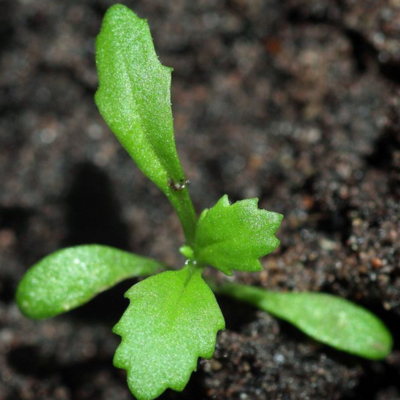Groundsel is a short, hairy annual growing to 40cm in height. Though small, groundsel can grow in large numbers across fields and hence are a very visible weed within crops.
Groundsel

What is groundsel?
Groundsel (Senecio vulgaris) can be found throughout lowland areas of the UK and Ireland. Groundsel is an annual plant, favouring cultivated or disturbed ground and preferring neutral to alkaline soil types.

How can I identify groundsel?
Groundsel is a short, hairy annual growing to 40cm in height. The leaves are pinnately lobed and hairless above. Cotyledons are narrow and often purplish below. Flowers are yellow daisy like in appearance and the sepals are black tipped.
Biology
Groundsel germinates in the autumn and the spring and hence is evident in most crop types. Groundsel is a short, hairy annual typically 10-40cm in height. Plants can overwinter and groundsel has a lifecycle of about 6 weeks and hence it is difficult to control effectively, and seed return can be high. Seeds can be wind dispersed and germinate from a depth of about 2cm. The seed longevity within the soil can be over 5 years. The flowerhead produces a number of daisy-like flowers and seed estimates of 2000-3500 seeds per plant.

Why is groundsel a problem?
Though small, groundsel can grow in large numbers across fields and hence are a very visible weed within crops. Groundsel grows readily in any disturbed soil and germinating in the autumn or the spring are a weed presence in any crop. The autumn germinating plants can be particularly troublesome to control as under cool/cold conditions the leaves become waxy and foliar applied herbicides may be less effective as leaf penetration is impeded. The lifecycle of groundsel is approximately 6-8 weeks and hence achieving complete control is difficult. Poor control has been linked to resistance to ALS herbicides (HRAC Group 2) however, as nothing has been confirmed in the UK (HRAC August 2024) and the weed is being closely monitored to ascertain the resistance status.
How do I control groundsel?
In cereal crops, flufenacet + diflufenican products have activity when applied at the pre-emergence timing. At the post-emergence timing, control is achieved using florasulam, pyroxsulam or SU based chemistry. Zypar®, containing florasulam and halauxifen methyl can be applied from 15th September to 30th June and controls groundsel up to 4 true leaves. Spitfire® and Starane® XL (florasulam + fluroxypyr) provide control up to 4 true leaves. The pyroxsulam based products (Avocet®, Broadway® Star, Memphis®) control groundsel up to 6 true leaves. Control declines when plants are flowering.
In potatoes, Titus® (rimsulfuron) plus Vivolt adjuvant provides suppression of groundsel, with control being improved by tank mixing with metribuzin.
In maize, the following products will control groundsel up to 4 true leaves; Principal® Forte (containing dicamba, nicosulfuron and rimsulfuron) + adjuvant can be applied from 1st May to 31st July. Dragster®, containing rimsulfuron + thifensulfuron plus adjuvant can be applied from 1st May to 31st July. Titus® (rimsulfuron) plus Vivolt adjuvant provides suppression of groundsel up to 4 true leaves. Accent® (nicosulfuron) can be applied from 2-8 leaf stage of maize and will control groundsel up to 4 true leaves.
In oilseed rape, the following products have activity on groundsel; Astrokerb® (propyzamide + aminopyralid) can be applied from 1st October to 31st January and when used at 1.5 L/ha gives control up to 6 true leaf stage. Korvetto® (clopyralid + halauxifen methyl) can be applied from March 1st to before June 1st and gives suppression up to 4 true leaves.
Product choice
Accent Herbicide
Accent® provides broad-spectrum weed control in forage maize.
Astrokerb Herbicide
Astrokerb® is a contact and residual herbicide delivering control of blackgrass, poppy, mayweed and other grass and broad-leaved weeds in winter oilseed rape.
Avocet Herbicide
Avocet®, a post-emergence ALS inhibitor for use on winter wheat, rye and triticale for the control of blackgrass and other grasses and broad-leaved weeds.
Broadway Star Herbicide
Broadway® Star delivers outstanding performance in winter wheat against yield robbing grassweeds including wild oats, ryegrasses and bromes.
Dragster Herbicide
Dragster® is a post-emergence herbicide that controls a wide range of both grass and broad-leaved weeds.
Korvetto Herbicide
Korvetto® is a selective post-emergence spring applied herbicide for use on winter oilseed rape.
Memphis Herbicide
Memphis® provides a robust solution for control of key grassweeds and broad-leaved weeds in winter wheat, winter rye, winter spelt and winter triticale.
Principal Forte Herbicide
Principal® Forte is a post-emergence herbicide that controls a wide range of both grass and broad-leaved weeds.
Spitfire Herbicide
Spitfire® helps combat a wide range of broad-leaved weeds in cereal crops, for use in both autumn and spring.
Starane XL Herbicide
Starane® XL controls cleavers and a range of other broad-leaved weeds in cereals.
Titus Herbicide
Titus® is a sulfonylurea herbicide to control broad-leaved weeds in potato and forage maize.
Zypar Herbicide
Zypar® is a herbicide for the control of broad-leaved weeds in winter cereals (wheat, durum wheat, spelt, barley, rye, triticale, oats) and spring cereals.